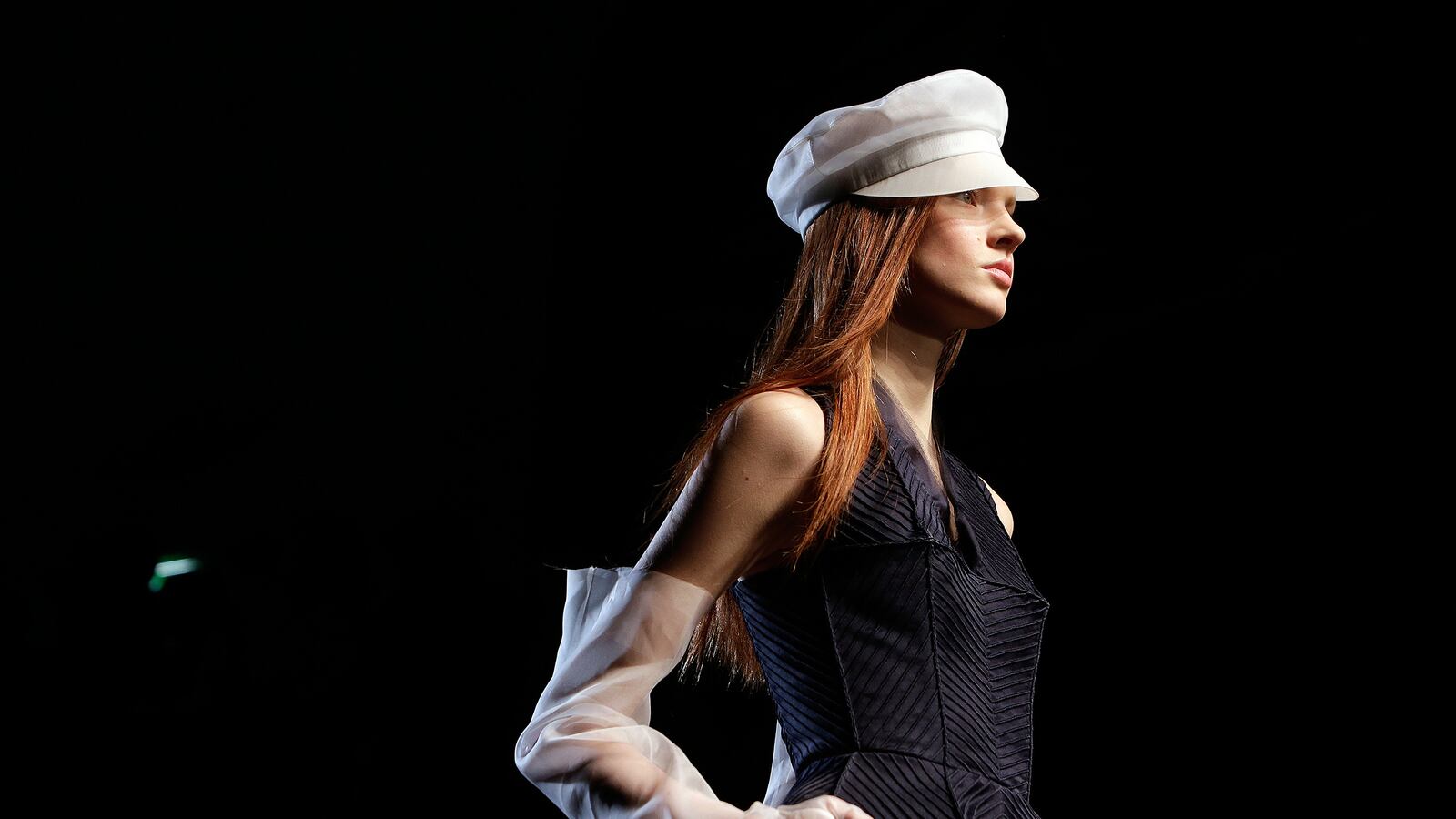It is a fashion mainstay. Somehow—season to season—our love of the sea finds its way into the wardrobes of both couture wearer and mall rat, whether it be a striped Breton top, or crisp white pants.
Those playing with the nautical style for the Spring/Summer 2015 season include Lanvin, Chloé, Marc Jacobs, Louis Vuitton, Anthony Vaccarello and Jacquemus. As Vogue put it, the marine inspiration runs the gamut of oversized coats to yachting-inspired dresses.
The fashion designer Jean-Paul Gaultier is probably the best-known designer inspired by nauticals. Gaultier was fond of sporting tight-fitting sailor tops on the British TV series Eurotrash, in the 1990s, although seafaring first influenced style in the 18th century.
One of the earliest nautical fashion moments was in 1778, when Parisian women donned ship headdresses after a maritime set-to between the British and the French. The French boat, the Belle Poule, got into a battle with a British ship called Arethusa, which led to the French involvement in the American War of Independence (not to mention a new hairdo).
Named the Coiffure à la Belle Poule, it was, “an elaborate hairstyle containing a replica of the ship itself,” explains Amber Jane Butchart, the London-based fashion historian and author of the forthcoming book Nautical Chic, which charts the history of what she calls coastal couture.

After the boating incident, she continues, sailor styles emerged again and again. They could be seen in Coco Chanel’s designs and those of Malcolm McLaren and Vivienne Westwood with their pirate punk looks, and right up to the current Spring/Summer 2015 collections.
McLaren and Westwood’s first catwalk collection in 1981, “the World's End” collection, played on the golden age of shipping piracy. It was a style that became popularized in the dress and makeup wildness of ’80s pop, with groups like Adam and The Ants.
“Nautical is such a perennial trend,” Butchart says. “Seafaring has also birthed some of our most-loved items of clothing, from the duffel coat to the striped fisherman’s top, the pea coat and the blazer which all have nautical origins.”
Her book, which will be released March 30 by Thames & Hudson, will be accompanied by a series of lectures at London’s Museum of Curiosities, where one can learn more about the subject.
For example, the sailor suit was first popularized as children’s wear as early as 1846, in a portrait by the German painter Winterhalter of Queen Victoria’s son, Prince Albert (later Edward VII), aged 4. He was “wearing a replica outfit that had been created for him by the ship’s tailor for the Royal Yacht,” said Butchart, who is an associate lecturer at the London College of Fashion.
Sailor chic was given the royal stamp of approval again when Princess Alexandra, the future Queen Consort of the United Kingdom, wore a sailor-inspired suit to Cowes yachting week in 1884.
Butchart grew up by the sea and so her interest evolved naturally. She even wrote her thesis on nautical influence for her MA at the London College of Fashion; the book has been 10 years in the making.
It’s surprising, Butchart said, that there hasn’t been a book covering nautical style before, as it’s such a popular trend on catwalks. “Our seafaring past has had an overwhelming effect on the way we dress, from waterproofs to the sailor collar and wide trousers. Designers such as Chanel and—of course—Gaultier have signature pieces based on nautical dress, she added.
Indeed, Gaultier regularly reinvents the nautical stripe, as well as the square collar sailor top, and often appears in his signature maillot top.
“Beginning with the fisherman and later the sailor, the blue-and-white stripe has become a marker for French identity and is the ultimate in nautical chic,” Butchart said.
Gaultier has also gone in for some sexy and memorable interpretations of the look with, for example, his “Pin Up Boys” summer 1996 collection. One outfit featured a sailor ensemble made of Neoprene and Spandex. “He incorporates elements of fetishwear to present the sailor as an explicitly sexual object,” Butchart said.
Many of Chanel’s early designs were inspired by workwear, such as French fishermen’s kits.
“Chanel herself was an avid salmon fisher during her visits to Scotland with the Duke of Westminster from the mid 1920s,” said Butchart. “Karl Lagerfeld even designed a Chanel fishing kit, complete with quilted leather and double C logo, to commemorate this in 2008. In the 1950s the blazer also became a key part of the Chanel look.”
Nauticals featured in a fashion feature in Life magazine in 1940, during WWII. “It featured everything from clutches embroidered with Admiral’s swords, to anchor and rope designs to be painted onto stockings with waterproof paint,” Butchart said. “They also showed belts decorated with boats and emblazoned with suggestive phrases like ‘We are ready for a fight or a frolic!’”
To tell more of the story of garments like the duffel coat, or the yellow fisherman’s macintosh, or the yacht club blazer, and how they made their way into fashion, Butchart weaves together tales from politics to war, leisure, sport and seafaring adventures in five chapters, covering each of the Maritime professions: The Officer, The Sailor, The Fisherman, The Sportsman, and The Pirate.
One of the chapters looks at how the Fishermen’s occupational clothing gave rise to chic classics through the “Bohemian embrace of Riviera lifestyle in the 1920s.”
It details how blue-and-white stripes became the choice design for icons like Chanel, Pablo Picasso, Audrey Hepburn, Brigitte Bardot, and Andy Warhol.
“The Sailor” chapter explores the “sex appeal of the beefcake sailor on shore leave,” while luxury, leisure, and the yachting lifestyle come together in the all-American figure of “The Sportsman.” The sailor should really take a bow: an endlessly malleable fashion object, and one with centuries of wll-dressed staying power.






